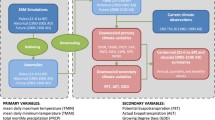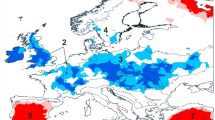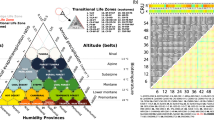Abstract
Understanding how predicted species responses to climate change are affected by advances in climate modeling is important for determining the frequency with which vulnerability assessments need to be updated. We used ecological niche models to compare predicted climatic habitat suitability for 132 species of reptiles and amphibians in California, USA under the previous and current generations of climate simulations from the Coupled Model Intercomparison Project (CMIP3 and CMIP5). We used data from seven global climate models for future (2014–2060) predictions under the following greenhouse gas emissions scenarios: SRES A2 for CMIP3 and RCP 8.5 for CMIP5. Ensembles of these climate models predicted a warmer and slightly wetter future California on average: CMIP3 + 2 °C mean annual temperature, +15 mm annual precipitation, CMIP5 + 2.5 °C mean annual temperature, +24 mm annual precipitation. CMIP3 and CMIP5 ensembles differed in where precipitation changes were predicted to be largest, with CMIP3 predicting greatest increased precipitation in the northern deserts and CMIP5 predicting greatest increased precipitation in the northern mountains. Under both sets of climate models (CMIP3 and CMIP5), mean habitat suitability within species ranges was predicted to decrease in the future. The degree of predicted decline was similar on average for CMIP3 and CMIP5, −15 % and −13 % respectively, suggesting that conclusions drawn from previous studies using ensembles of CMIP3 models are robust, at least for California. However, the effect of CMIP3 vs. CMIP5 on future mean habitat suitability depended strongly on which GCM was used: three GCMs predicted little change in future habitat suitability between CMIP3 and CMIP5 (MIROC, CNRM, GFDL), three predicted greater reductions in habitat suitability under CMIP3 (MPI, GISS, IPSL), and one predicted greater reductions in habitat suitability under CMIP5 (MRI). We conclude that habitat suitability assessments under CMIP3 made using more than 3 GCMs are likely to remain broadly applicable, while those made using 3 or fewer may be conservation priorities for re-evaluation under CMIP5.





Similar content being viewed by others
References
Araújo MB, New M (2007) Ensemble forecasting of species distributions. Trends Ecol Evol 22:42–47
Araújo MB, Thuiller W, Pearson RG (2006) Climate warming and the decline of amphibians and reptiles in Europe. J Biogeogr 33:1712–1728
Bates D, Maechler M, Bolker B, Walker S (2014) lme4: Linear mixed-effects models using Eigen and S4. R package version 1.0–6
Beaumont LJ, Hughes L, Pitman AJ (2008) Why is the choice of future climate scenarios for species distribution modelling important? Ecol Lett 11:1135–1146
Conant R, Collins JT (1998) A field guide to reptiles & amphibians: eastern and central North America. Houghton Mifflin Company
Dufresne JL, Foujols MA, Denvil S, et al. (2013) Climate change projections using the IPSL-CM5 earth system model: from CMIP3 to CMIP5. Clim Dyn 40:2123–2165
Elith J, Leathwick JR (2009) Species distribution models: ecological explanation and prediction across space and time. Annu Rev Ecol Evol Syst 40:677–697
Elith J, Phillips SJ, Hastie T, Dudik M, Chee YE, Yates CJ (2011) A statistical explanation of MaxEnt for ecologists. Divers Distrib 17:43–57
Franklin J (2010) Mapping species distributions: spatial inference and prediction. Cambridge University Press
Graham CH, Hijmans RJ (2006) A comparison of methods for mapping species ranges and species richness. Glob Ecol Biogeogr 15:578–587
Guisan A, Rahbek C (2011) SESAM–a new framework integrating macroecological and species distribution models for predicting spatio-temporal patterns of species assemblages. J Biogeogr
Hawkins E, Sutton R (2009) The potential to narrow uncertainty in regional climate predictions. Bull Am Meteorol Soc 90:1095–1107
Hijmans RJ, Cameron SE, Parra JL, Jones PG, Jarvis A (2005) Very high resolution interpolated climate surfaces for global land areas. Int J Climatol 25:1965–1978
Hijmans RJ, Phillips S, Leathwick J, Elith J (2013). dismo: Species distribution modeling. R package version 0.9–3
Hof C, Araújo MB, Jetz W, Rahbek C (2011) Additive threats from pathogens, climate and land-use change for global amphibian diversity. Nature 480:516–519
Kearney MR, Wintle BA, Porter WP (2010) Correlative and mechanistic models of species distribution provide congruent forecasts under climate change. Conserv Lett 3:203–213
Knutti R, Sedláček J (2012) Robustness and uncertainties in the new CMIP5 climate model projections. Nat Clim Chang 3:369–373
Kuznetsova A, Brockhoff PB, Christensen RHB (2013) lmerTest: Tests for random and fixed effects for linear mixed effect models (lmer objects of lme4 package) R package version 1.2–0
Leemans R, Solomon AM (1993) Modeling the potential change in yield and distribution of the earth’s crops under a warmed climate. Clim Res 3:79–96
McKenney DW, Pedlar JH, Rood RB, Price D (2011) Revisiting projected shifts in the climate envelopes of north American trees using updated general circulation models. Glob Chang Biol 17:2720–2730
Meehl GA, Covey C, McAvaney B, Latif M, Stouffer RJ (2005) Overview of the coupled model intercomparison project. Bull Am Meteorol Soc 86:89–93
Milanovich JR, PetermanWE NNP, Maerz JC (2010) Projected loss of a salamander diversity hotspot as a consequence of projected global climate change. PLoS One 5:e12189
Moss RH, Edmonds JA, Hibbard KA, Manning MR, Rose SK, van Vuuren DP, Carter TR, Emoir S, Kainuma M, Kram T, Meehl GA, Mitchell JFB, Nakicenovic N, Riahi K, Smith SJ, Stouffer RJ, Thomson AM, Weyant JP, Wilbanks TJ (2010) The next generation of scenarios for climate change research and assessment. Nature 463:747–756
Nakicenovic N, Alcamo J, Davis G, de Vries B (2000) Special report on emissions scenarios: a special report of Working Group III of the Intergovernmental Panel on Climate Change
Ochoa-Ochoa LM, Rodríguez P, Mora F, Flores-Villela O, Whittaker RJ (2012) Climate change and amphibian diversity patterns in Mexico. Biol Conserv 150:94–102
Pearson RG, Raxworthy CJ, Nakamura M, Townsend Peterson A (2007) Predicting species distributions from small numbers of occurrence records: a test case using cryptic geckos in Madagascar. J Biogeogr 34:102–117
Peters GP, Andrew RM, Boden T, Candell JG, Ciasis P, Le Quéré C, Marland G, Raupach MR, Wilson C (2012) The challenge to keep global warming below 2 °C. Nat Clim Chang 3:4–6
Peterson AT, Soberón J, Pearson RG, Anderson RP, Martinez-Meyer E, Nakamura M, Araújo MB (2011) Ecological niches and geographic distributions. Princeton University Press Princeton, NJ
Phillips SJ, Dudík M (2008) Modeling of species distributions with Maxent: new extensions and a comprehensive evaluation. Ecography 31:161–175
Phillips SJ, Anderson RP, Schapire RE (2006) Maximum entropy modeling of species geographic distributions. Ecol Model 190:231–259
Phillips SJ, Dudík M, Elith J, Graham CH, Lehmann A, Leathwick J, Ferrier S (2009) Sample selection bias and presence-only distribution models: implications for background and pseudo-absence data. Ecol Appl 19:181–197
R Core Team (2013) R: a language and environment for statistical computing. R Foundation for Statistical Computing, Vienna
Ramirez J, Jarvis A (2008) High resolution statistically downscaled future climate surfaces. International Center for Tropical Agriculture (CIAT); CGIAR Research Program on Climate Change, Agriculture and Food Security (CCAFS). Cali, Colombia
Reichler T, Kim J (2008) How well do coupled models simulate today's climate? Bull Am Meteorol Soc 89:303–311
Rogelj J, Meinshausen M, Knutti R (2012) Global warming under old and new scenarios using IPCC climate sensitivity range estimates. Nat Clim Chang 2:248–253
Rowland EL, Davison JE, Graumlich LJ (2011) Approaches to evaluating climate change impacts on species: a guide to initiating the adaptation planning process. Environ Manag 47:322–337
Stebbins RC (2003) A field guide to western reptiles and amphibians. Houghton Mifflin Harcourt
Taylor KE, Stouffer RJ, Meehl GA (2012) An overview of CMIP5 and the experiment design. Bull Am Meteorol Soc 93:485–498
Thorne JH, Seo C, Basabose A, Gray M, Belfiore NM, Hijmans RJ (2013) Alternative biological assumptions strongly influence models of climate change effects on mountain gorillas. Ecosphere 4:art108
Trenberth K (2010) More knowledge, less certainty. Nature Reports Clim Change 4:20–21
Vuuren DP, Edmonds J, Kainuma M, et al. (2011) The representative concentration pathways: an overview. Clim Chang 109:5–31
Warren DL, Seifert SN (2011) Ecological niche modeling in Maxent: the importance of model complexity and the performance of model selection criteria. Ecol Appl 21:335–342
Warren DL, Wright AN, Seifert SN, Shaffer HB (2014) Incorporating model complexity and spatial sampling bias into ecological niche models of climate change risks faced by California vertebrate species of concern. Divers Distrib 20:334–343
Wright AN, Hijmans RJ, Schwartz MW, Shaffer, HB (2013) California amphibian and reptile species of future concern: conservation and climate change Final Report to the California Department of Fish and Wildlife, Nongame Wildlife Program, Task 12, Contract No P0685904
Wright AN, Hijmans RJ, Schwartz MW, Shaffer H (2015) Multiple sources of uncertainty affect metrics for ranking conservation risk under climate change. Divers Distrib 21:111–122
Acknowledgments
This work was funded by the U.S. Department of the Interior Southwest Climate Science Center, the California Department of Fish and Wildlife’s Nongame Wildlife Program via a State 2006-07 One-Time General Fund Augmentation for Nongame Fish and Wildlife Trust Resources, and State Wildlife Grant T-28-R-1 from the U.S. Fish and Wildlife Service.
Author information
Authors and Affiliations
Corresponding author
Rights and permissions
About this article
Cite this article
Wright, A.N., Schwartz, M.W., Hijmans, R.J. et al. Advances in climate models from CMIP3 to CMIP5 do not change predictions of future habitat suitability for California reptiles and amphibians. Climatic Change 134, 579–591 (2016). https://doi.org/10.1007/s10584-015-1552-6
Received:
Accepted:
Published:
Issue Date:
DOI: https://doi.org/10.1007/s10584-015-1552-6




